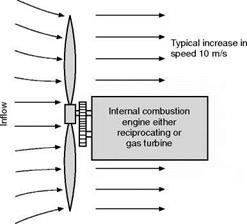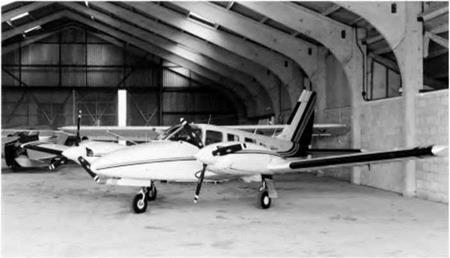Engine and propeller propulsion
Finally, we come to the old and well-tried system of a propeller driven by an internal combustion engine (Figs 4.4 and 4E, overleaf). Here there is the clear dividing line between the propeller and the engine. We shall consider the propeller in more detail later in this chapter. There are, of course, some problems of airflow even in a reciprocating engine, and we may often use the ram effect of a forward-facing intake as an aid to raising the pressure of the incoming air, just as we may use the backward exhaust as a partial form of jet propulsion. In the cooling system we may even emulate the ramjet by collecting the air in ducts, using the otherwise wasted heat of the engine to give it energy, and ejecting it through a venturi tube – another little bit of jet propulsion. Or, of course, the engine that drives the propeller may itself be a gas turbine, and in this case we can allot almost at will the proportion of the power that we take from the propeller and from the jet respectively as in the turboprop system.
Thrust and momentum
All these systems have the common feature that they provide thrust as a result of giving momentum to the air, or other gases. In accordance with the principles of mechanics the amount of thrust provided will be equal to the rate at which momentum is given to the air.
In symbols, if m kilograms is the mass of air affected per second, and if it is given an extra velocity of v metres per second by the propulsion device, then the momentum given to the air per second is mv, so
T = mv
|
|
Fig 4.4 Principle of propeller propulsion
|
|
Fig 4E Piston engine and propeller
The piston engine and propeller is still the most common arrangement for light general aviation aircraft.
Now clearly the same thrust could be provided by a large m and a small v, or by a small m and a large v; in other words, by giving a large mass of air a small extra velocity or a small mass of air a large extra velocity. Which will work best in practice?
Let us now work a step further in symbols and figures. To make life easy, we will choose to consider the case of a stationary aircraft, perhaps just about to start its take-off run. Now the rate at which kinetic energy is given to m kg of air per second to produce a slipstream or jet speed of vmk is 2 mv2 watts. So while 1 kg/s given 10 m/s has the same rate of momentum change and therefore produces the same thrust as 10 kg/s given 1 m/s, the rate of change of energy of the former is
1 X 1 X 102 = 50 watts
2
and of the latter
— X 10 X l2 = 5 watts
2
It is clear therefore that the latter will require less work and that there will be less waste of energy; in other words, it will be more efficient than the former as a means of producing thrust.
From this point of view the propeller comes first because it throws back a large mass of air at comparatively low velocity, the jet engine comes next, and the rocket a bad third in that it throws back a very small mass at a very high velocity.
You may wonder therefore why propellers ever started to go out of fashion. The problem is that it is difficult to make them work well at high speed. Since the propeller has a rotational as well as a forward speed, it follows that the blade tips will start to move through the air faster than the speed of sound long before the rest of the aircraft. The occurrence of supersonic flow at the blade tips causes all sorts of problems, and although great advances in propeller design have been made, jet propulsion provides the only practical alternative for high-speed flight.













